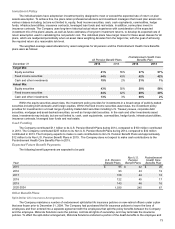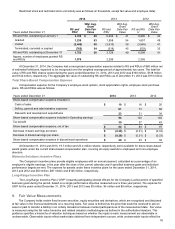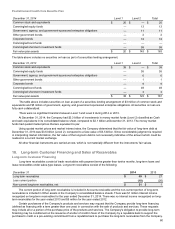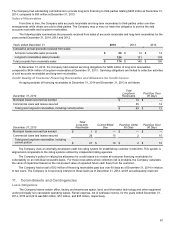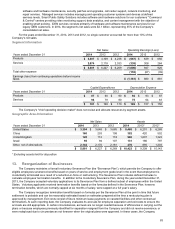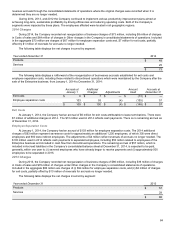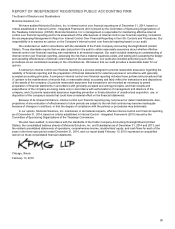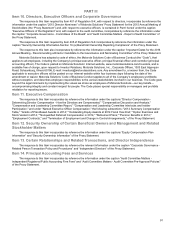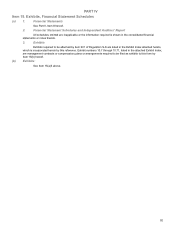Motorola 2014 Annual Report Download - page 84
Download and view the complete annual report
Please find page 84 of the 2014 Motorola annual report below. You can navigate through the pages in the report by either clicking on the pages listed below, or by using the keyword search tool below to find specific information within the annual report.
82
At December 31, 2014, future minimum lease obligations, net of minimum sublease rentals, for the next five years and
beyond are as follows:
Year
2015 $ 68
2016 56
2017 45
2018 35
2019 33
Beyond 217
Purchase Obligations
During the normal course of business, in order to manage manufacturing lead times and help ensure adequate component
supply, the Company enters into agreements with contract manufacturers and suppliers that either allow them to procure
inventory based upon criteria as defined by the Company or establish the parameters defining the Company’s requirements. In
addition, we have entered into software license agreements which are firm commitments and are not cancelable. As of
December 31, 2014, the Company had entered into firm, noncancelable, and unconditional commitments under such
arrangements through 2017. The Company expects to make total payments of $40 million under these arrangements as follows:
$23 million in 2015, $14 million in 2016, and $3 million in 2017.
The Company outsources certain corporate functions, such as benefit administration and information technology related
services, the longest of which is expected to expire in 2019. The remaining payments under these contracts are approximately
$319 million over the remaining life of the contracts; however, these contracts can be terminated. Termination would result in a
penalty substantially less than the remaining annual contract payments. The Company would also be required to find another
source for these services, including the possibility of performing them in-house.
Legal
The Company is a defendant in various lawsuits, claims and actions that arise in the normal course of business. While the
outcome of these matters is currently not determinable, the Company does not expect the ultimate disposition of these matters
to have a material adverse effect on the Company’s consolidated financial position, liquidity or results of operations.
Indemnifications
The Company is a party to a variety of agreements pursuant to which it is obligated to indemnify the other party with
respect to certain matters. In indemnification cases, payment by the Company is conditioned on the other party making a claim
pursuant to the procedures specified in the particular contract, which procedures typically allow the Company to challenge the
other party's claims. In some instances, the Company may have recourse against third-parties for certain payments made by
the Company.
Some of these obligations arise as a result of divestitures of the Company's assets or businesses and require the
Company to indemnify the other party against losses arising from breaches of representations and warranties and covenants
and, in some cases, the settlement of pending obligations. The Company's obligations under divestiture agreements for
indemnification based on breaches of representations and warranties are generally limited in terms of duration, and for amounts
for breaches of such representations and warranties in connection with prior divestitures not in excess of a percentage of the
contract value. The Company had no pending claims at December 31, 2014.
In addition, the Company may provide indemnifications for losses that result from the breach of general warranties
contained in certain commercial and intellectual property agreements. Historically, the Company has not made significant
payments under these agreements.
12. Information by Segment and Geographic Region
The Company conducts its business globally and manages through following two segments:
Products: The Products segment offers an extensive portfolio of infrastructure, devices, accessories, and
software. The primary customers of the Products segment are government, public safety and first-responder agencies,
municipalities, and commercial and industrial customers who operate private communications networks and manage a
mobile workforce. The Products segment is comprised of Devices and Systems. Devices includes two-way portable
and vehicle-mounted radios, accessories, software features and upgrades. Systems includes the radio network core
and central processing software, base stations, consoles, repeaters, and software applications and features. In 2014,
the segment’s net sales were $3.8 billion, representing 65% of the Company's consolidated net sales.
Services: The Services segment provides a full set of offerings for government, public safety and commercial
communication networks including: (i) Integration services, (ii) Lifecycle Support services, (iii) Managed services, (iv)
Smart Public Safety Solutions, and (v) iDEN services. Integration services includes implementation, optimization, and
integration of networks, devices, software, and applications. Lifecycle Support services includes lifecycle planning,



